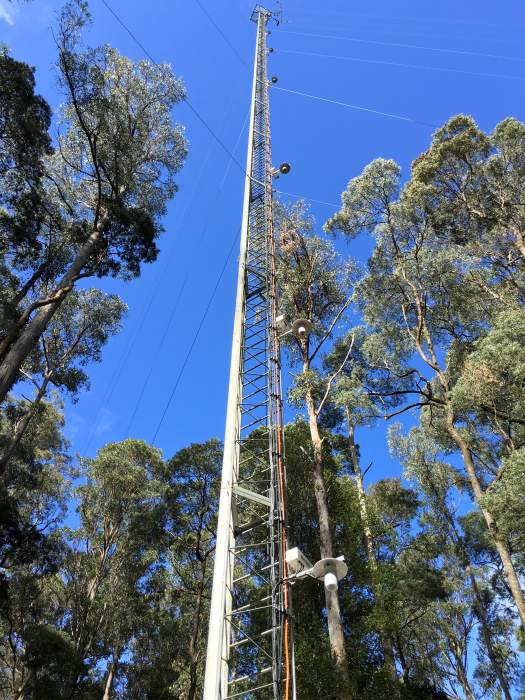





The Warra long-term ecological research (LTER) site located in Southwestern Tasmania was founded in 1995 to monitor long-term ecological health and dynamics within a wet eucalyptus forest. The site area consists of 15,900 hectares (61.4 square miles), partly contained within the Tasmanian Wilderness World Heritage Area (managed for conservation) and partly within state forest (managed for multiple uses, including timber production). Studies at the site have the following main research objectives:
- To study the eco-physiological processes and rates of carbon accumulation and decomposition in a mixed-age, tall, wet Eucalyptus obliqua forest originating from past natural wildfires
- To measure the exchanges of carbon dioxide, water vapor, and energy between the forest and the atmosphere using eddy-covariance micrometeorological techniques
- To link eco-physiological processes and rates of carbon accumulation and decomposition with the site biota
- To use flux tower measurements, in combination with remote sensing data and land surface models, to upscale and estimate the net exchanges of carbon and water at regional scales
The Warra LTER site includes a flux tower that is part of the OzFlux Network (www.ozflux.org.au) and the Australian Supersites Network. The flux tower consists of an 80-meter (262-foot) guyed steel-lattice tower. Turbulent fluxes of heat, water vapor, and carbon dioxide are measured at the top of the tower using a Campbell Scientific CPEC200 Closed-Path Eddy-Covariance System with a vortex sample intake. A combination of a Campbell Scientific AP200 profile system with eight intakes and a series of Apogee aspirated temperature sensors provides a vertical profile of water vapor, carbon dioxide, and temperature.
The profiles are used to calculate the change in storage (i.e., accumulation or depletion) of the two gases and heat. The change in storage is added to the turbulent fluxes to determine a total flux or net ecosystem exchange for each scalar. A profile system is particularly useful at a site like Warra where the change in storage is significant in times of lower turbulence intensity (e.g., at night) and within the especially large forest canopy.
Supplementary measurements are also made above the canopy with Campbell Scientific instruments, including temperature and humidity, wind speed and direction, rainfall, incoming and reflected shortwave radiation, and net radiation. At ground level, soil moisture content is measured using time-domain reflectometry (TDR) instruments, while soil heat fluxes and soil temperature are also measured.
Since the Warra LTER site was established, more than 200 research projects have been undertaken at the site, and ten of those projects have been designated icon projects, designed with the specific intent of continuing remeasurement in the long term (more than 15 years). The Warra flux tower is one of these ten icon projects.
Note: TERN Australia has posted a video about this project on Vimeo: https://vimeo.com/260745357.
Case Study Summary
Application
Long-term ecological studies in wet eucalyptus forestLocation
Warra LTER site, Tasmania, AustraliaProducts Used
CR3000 CPEC200 CR1000 AP200Contributors
Campbell Scientific AustraliaTim Wardlaw, Forestry Tasmania
Participating Organizations
Forestry TasmaniaMeasured Parameters
Vertical profiles of CO2 density, H2O density, and temperature for calculation of change in storage; high-frequency measurements of CO2 density, H2O density, sonic temperature, and 3D wind used to calculate eddy fluxes; air temperature; humidity; wind speed and direction; rainfall; incoming and outgoing shortwave radiation; net radiation; phenology; soil water content; soil heat flux; soil temperatureRelated Website
Warra Tall Eucalypt SuperSiteOzFlux Land-Atmosphere Observatory
Warra Long-Term Ecological Research
View the PDF